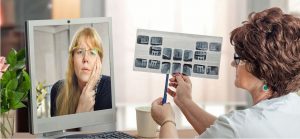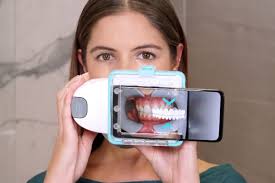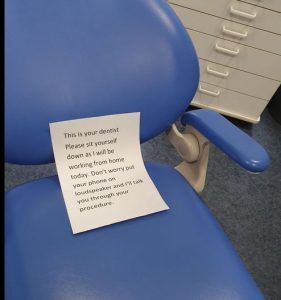(Clonmel Orthodontics blogs are intended to be factual rather than aspirational or for purely marketing purposes.)
Teledentistry
First of all ,what does tele mean? tele– is a combining form, meaning distant as in telescope- to see distant things, telephone- to hear distant things.
Teledentistry maybe defined as the application of various information and communications technologies to facilitate dental care for geographically distant patients . In its simplest form
The first application of teledentistry was in 1994 by the U.S. army to see if dental expertise could be applied from a distant location.
The main benefit of teledentistry is that it eliminates the need for travel by the patient and or the dental practitioner.In its simplest form, discussing with a patient over the telephone how to deal with a wire that is poking out is a form of teledentistry.
In orthodontics teledentistry can be used in both;
(1) The diagnosis and planning of patients treatment.
(2) Monitoring the progress of treatment.
The diagnosis and planning of orthodontic patients treatment
Video conferencing can be used for a patients initial consultation or virtual consultation, however if a high standard of treatment care is to be maintained, ultimately the patient will have to attend in person for diagnostic records. These can include the following x-rays, photographs, study models, intra-oral scan. If clarification about the consultation or a discussion with a parent who was absent for the original consultation is required, obviously this can be conducted using video-conferencing or virtually.
Monitoring the progress of orthodontic treatment
Another use of teledentistry in orthodontics is remote treatment monitoring. Patients are now able to accurately capture their tooth movements using a smartphone . These photos (or, sometimes, videos) are then relayed to the orthodontist, who is able to provide real-time monitoring of the patient’s treatment away from the office. At the forefront of this technology are Dental Monitoring and Mouth Watch by Teledent.
Dental Monitoring system in use.
Dental monitoring offer packages to orthodontists with various levels of sophistication, from simply reviewing the photographs , to monitoring the actual tooth movements based on an stl file from the patients initial scan
This technology is very intensely marketed, especially as a means of monitoring patients who are wearing aligners. It is important to remember that remote monitoring still requires a clinical diagnosis with full records this will require an in person consultation. Initial appliances with attachments must be placed by the orthodontist. How to monitor treatment and how frequently, is up to the clinician and the patient. Nevertheless, remote monitoring opens the door for possible problems. At what point could fewer in-person visits and increased convenience become unmonitored treatment that diminishes the standard of care. Particularly when monitoring is combined with appliances which have a relatively low level of accuracy of 50%. The fact that these appliances are being monitored using the latest technology will not of course get the plastic aligners to move the teeth any more accurately or more quickly. The aligner is an aligner whether it is being watched or not. Subtle changes like a deficient attachment or possible early decalcification maybe missed. Patients who are compliant and take enough interest in their treatment to upload good quality photographs every week are generally not the patients who require weekly monitoring. By contast the patient who doesn’t practise good oral hygiene or comply with the original treatment instructions regarding wear and care of the appliances, may not bother uploading good quality pictures on a weekly basis.
I personally would prefer to see my patients in my practice regularly, after all this is what they are paying for. Teledentistry undoubtedly has a role, particularly in the current era of lockdowns, and with our increasingly busy lives. It is important to apply common sense and not to be overwhelmed by our enthusiam for new technology , teledentistry in orthodontics definitely has a role, but intensive marketing should not let us ignore the weak links in this method of providing orthodontic treatment.
“Your scientists were so preoccupied with whether or not they could, they didn’t stop to think if they should.—Michael Crichton, Jurassic Park” . Neal Kravitz et al. JCO.
……………………………………………………………………………………………………………………………………………………..
(Clonmel Orthodontics blogs are intended to be factual rather than aspirational or for purely marketing purposes)
This orthodontic blog was written by Dr John Buckley,who is a specialist orthodontist at Clonmel Orthodontics in Clonmel County Tipperary, Ireland.He is both Clonmel’s most qualified and most experienced orthodontist.
Clonmel Orthodontics provides orthodontics to county Tipperary and the neighbouring counties of Waterford, Kilkenny, Limerick,Cork , and beyond.
Dr Buckley has practised as a specialist orthodontist in Clonmel for over 20 years. In addition to his orthodontic qualifications which he held before he commenced orthodontic practice , Dr Buckley was awarded a First class masters degree in Lingual orthodontics from the University of Hannover medical school (MHH) in 2012. This masters degree is directed by Professor Dirk Wiechmann who is the inventor of both the incognito™ and win™ lingual appliances. Dr Buckley was the first orthodontist in Ireland to be awarded this qualification. In 2016 he was accepted as an active member of the European Society Of Lingual Orthodontics (ESLO). To become an active member it is necessary for candidates to submit the records of finished lingual cases. If the cases are deemed to be of a sufficiently high standard then the candidate is accepted as an active member of ESLO. Dr Buckley is the first and only orthodontist in Ireland to be accepted as an active member of ESLO.




